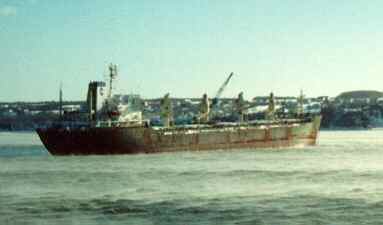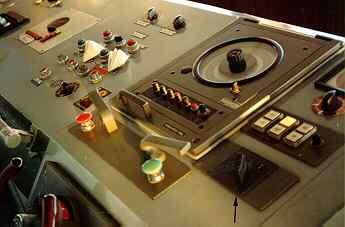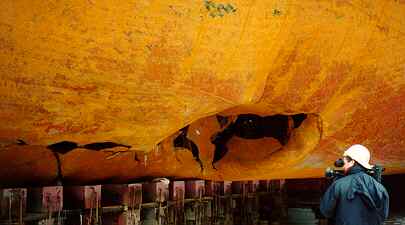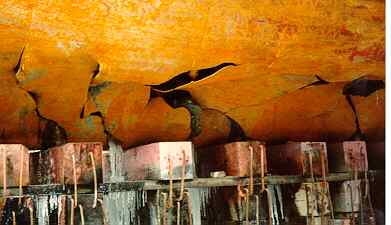Grounding of the bulk carrier "ANAX"
on the St. Lawrence River
off Beaumont, Quebec
The Transportation Safety Board of Canada (TSB) investigated this occurrence for the purpose of advancing transportation safety. It is not the function of the Board to assign fault or determine civil or criminal liability. This report is not created for use in the context of legal, disciplinary or other proceedings. See Ownership and use of content.
Summary
On 10 December 1994, the "ANAX", loaded with 17,717 metric tonnes of wheat from Duluth, USA, was transiting the St. Lawrence River bound for Baie Comeau, Quebec, with two pilots on board. When the vessel was off Beaumont, a power interruption occurred on the emergency electrical system supplying the navigation instruments and the steering position. A few minutes later, the vessel grounded on a rocky bottom on the south side of the channel. The vessel sustained major damage requiring drydocking. No one was injured, and no pollution was reported as a result of this occurrence.
Factual information
Particulars of the Vessel
| Name | "ANAX" |
|---|---|
| Port of Registry | Nassau, Bahamas |
| Flag | Bahamas |
| Official number | 723181 |
| Type | Cargo |
| Gross tonnage | 18,392 tons |
| Length | 189.6 m |
Draught |
Forward: 8.22 m |
| Built | 1979, Yugoslavia |
| Propulsion | MAN 2SA, five cylinders, 7,606 kW, driving a single fixed-pitch propeller |
Owners |
Anax Navigation Co. SA Panama 7 |
At 1215Footnote 1 on 10 December 1994, after changing pilots at Quebec, Quebec, the "ANAX" resumed her service speed on leaving the limits of the Port of Quebec bound for Baie Comeau. For more economical fuel consumption, the vessel switched from using diesel oil to heavy oil in the main engine.
At about 1310, when the vessel was off Beaumont, a power interruption paralyzed the navigation instruments and the steering position, and the vessel yawed to starboard. The bridge personnel immediately informed the engine-room staff of a steering gear failure by telephone and placed the engine telegraph to "full astern".
The surprised engine-room staff hesitated before responding to the manoeuvre. The master was urgently called to the bridge and ordered the engineers of the watch by telephone to reverse the main engine immediately. The manoeuvring order was carried out, but the vessel grounded, at about 1312, on the south side of the channel above buoy K147 before the engine was in reverse. The tide had been falling for about 1 hour and 30 minutes.
The "ANAX" grounded over a third of her length, with the stern remaining in open water. The forepeak, No. 1 double-bottom port and starboard tanks and No. 3 double-bottom starboard tank were staved in. The vessel had to be lightened by 1,800 tons, and the assistance of tugs was required, to be refloated at high tide on 14 December 1994.
During tests carried out in the presence of inspectors, the opening of the circuit breaker serving the emergency electrical system on the main switchboard produced more or less the same effects as were observed by the personnel on the bridge at the time of the grounding. No other scenario reproduced the same effects, and no part of the system involved was identified as a possible cause of this failure.
Post-occurrence inspections were carried out by inspectors of the Ship Safety Branch of the Canadian Coast Guard to determine the technical cause of the grounding and for Port State Control. Some noteworthy deficiencies were found as follows:
- the emergency generator failed to start automatically due to the presence of frozen water in its fuel line;
- the emergency generator circuit breaker did not close automatically;
- the short-circuit fuses in the emergency panel and the main panel for the steering motors were not as shown in the one-line diagram;
- indications of different function modes in the wheel-house were not evident if not missing;
- the power failure alarm system for the electric motors did not have a sound signal;
- the emergency telephone between the wheel-house and the engine-room was out of order;
- the motor of the starboard lifeboat could not be started; and
- the lifeboat launching mechanism was too slow.
Analysis
The "ANAX" has three main generators and an emergency generator with automatic circuit-breaker opening and closing. The steering gear is operated by two motors, one powered by the main generator and the other by the emergency electrical system. Each of these motors is equipped with a power unit; one powered by the main generator and the other by the emergency electrical system.
The main switchboard in the engine-room is connected to the emergency board in the emergency generator compartment. The latter supplies power to the navigation instruments, the alarms and the steering position in the wheel-house.
A switch on the steering position console can be used to select power unit No. 1 or power unit No. 2.
The two hydraulic pumps of the steering gear were in operation before the grounding. As the main electrical power source was available, one of the steering motors and one of the power units were still in operation. However, there were no instructions posted on the bridge setting out the procedures to be followed by personnel in the event of a steering gear failure, contrary to what is set out in the International Convention for the Safety of Life at Sea (SOLAS), 1974.
The opening of the circuit breaker on the main switchboard should have started the emergency generator automatically. Tests showed, however, that the emergency generator was not in starting condition and its circuit breaker was not closing automatically.
The main engine can be put into reverse in an emergency even if it is operating on heavy oil. However, there have to be precise operating procedures in use between the bridge watch personnel and the engine-room staff so that they can perform emergency manoeuvres without hesitation. The procedures in effect on board the "ANAX" did not allow for any such emergency manoeuvres.
Findings
- The opening of the emergency electrical system circuit breaker on the main switchboard appears to have caused the momentary power interruption which occurred on the bridge.
- Inspections, in conjunction with tests, established that no part of the electrical system involved was defective.
- 3. Following a detailed inspection, it was established that the emergency generator was not in working order.
- Better knowledge of the steering gear system as well as emergency procedures posted on the bridge would have enabled the watch personnel to act promptly and to regain control of steering.
- The main engine was running on heavy oil while the vessel was in confined waters.
- The engine could have been reversed even though it was operating on heavy oil.
Causes and Contributing Factors
The grounding of the "ANAX" is attributable to the opening of the circuit breaker of the emergency electrical system although the exact cause of this was not determined. The emergency generator failed to start automatically because of frozen water in its fuel line. There were no emergency procedures and the bridge watch personnel was unable to deal with the situation and avert the grounding.
This report concludes the Transportation Safety Board's investigation into this occurrence. Consequently, the Board, consisting of Chairperson, John W. Stants, and members Zita Brunet and Maurice Harquail, authorized the release of this report on .



